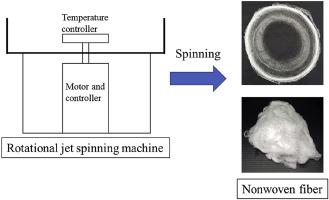Materials Today Sustainability ( IF 7.8 ) Pub Date : 2020-06-26 , DOI: 10.1016/j.mtsust.2020.100046 W. Rodchanasuripron , M. Seadan , S. Suttiruengwong

|
The preparation of non-woven polylactic acid (PLA) fibers was carried out by the rotational jet spinning method. The polymers were melted in a heat chamber and centrifuged with a high speed to obtain the fibers with the high productivity. The viscosity of polymers was an important factor for the quality and quantity of the non-woven fiber. In this work, a commercial grade and synthesized PLA were used to prepare the non-woven fiber. The non-woven PLA fibers were produced at different temperatures of 190–230 °C with rotational speed between 650 and 2800 rpm. The morphology of non-woven PLA was investigated by scanning electron microscopy. The effect of temperature was investigated by thermogravimetric analysis (TGA). The non-woven PLA had a smooth surface along the fibers. The result showed that as the temperature or rotational speed increased, the fiber diameter was decreased. The fiber diameters of PLA 3052D, L130, and synthesized PLA (at 650 rpm) decreased to 40%, 40%, and 24%, respectively, when increasing the temperature. The high temperature in the process led to generate the beads. The fiber diameter of PLA 3052D, L130, and synthesized PLA (at 190 °C) decreased to 66%, 23%, and 56%, respectively, with the higher rotational speed. Tonset of TGA showed that the thermal degradation of PLA fibers was reduced compared with PLA resin, but it was still considered to be insignificant after spinning. The wettability of the samples was determined by the mean of the water evaporation. The results showed that the weight of the water in the sample decreased rapidly compared with control cotton, indicating more hydrophobic nature of the fibers obtained at the high rotational speed and temperature.
中文翻译:

旋转喷射纺丝法制备的非织造聚乳酸纤维的性能
非织造聚乳酸(PLA)纤维的制备通过旋转喷射纺丝法进行。将聚合物在加热室中熔融并高速离心以获得具有高生产率的纤维。聚合物的粘度是影响非织造纤维质量和数量的重要因素。在这项工作中,使用商品级和合成的PLA制备了非织造纤维。非织造PLA纤维是在190–230°C的不同温度下生产的,转速在650和2800 rpm之间。通过扫描电子显微镜研究非织造PLA的形态。通过热重分析(TGA)研究了温度的影响。非织造PLA沿纤维具有光滑的表面。结果表明,随着温度或转速的增加,纤维直径减小。当温度升高时,PLA 3052D,L130和合成的PLA(在650 rpm下)的纤维直径分别降低至40%,40%和24%。该过程中的高温导致产生珠粒。随着转速的提高,PLA 3052D,L130和合成的PLA(在190°C下)的纤维直径分别降低至66%,23%和56%。ŤTGA的起效表明,与PLA树脂相比,PLA纤维的热降解有所降低,但是纺丝后仍被认为是微不足道的。样品的润湿性由水蒸发的平均值确定。结果表明,与对照棉相比,样品中水的重量迅速减少,表明在高转速和高温下获得的纤维具有更多的疏水性。

























 京公网安备 11010802027423号
京公网安备 11010802027423号